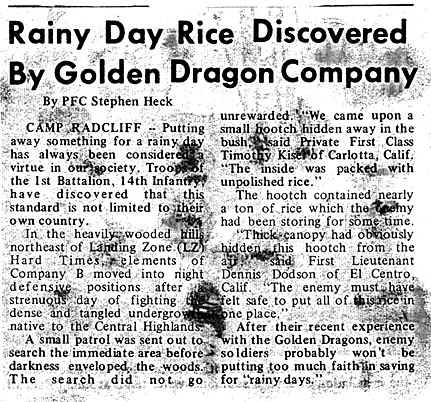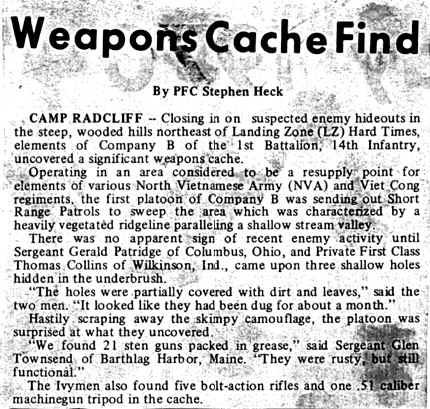 |
|
 |
 |
|
 |
Frustrating Fight Finds 8 NVA Dead After Week Search
May, 1970
After a frustrating week of being sniped at, elements of the 1st Battalion, 14th Infantry, retaliated by "fingering" eight of their tormenters for helicopter gunships and artillery.
A company of North Vietnamese soldiers (NVA) had set up camp in the mountainous regions northeast of Landing Zone Hard Times. However, their plans were abruptly disrupted when Company A of the 1st Battlion, 14th Infantry, assaulted into the area to kick off a difficult week-long clear and search operation.
On the lookout for possible NVA resupply bases and training areas, elements of the 2nd platoon under 2nd Lt. Thomas Thale, of Ballwin, Mo, discovered a hootch complex on the first day of the operation. It showed signs of recent use by approximately 15 individuals. As the platoons swept the area, it received 20 rounds of long range, AK 47 fire.
Starting out early the next day, members of the 2nd platoon spotted an individual dressed in khaki walking very rapidly down a trail. The enemy soldier disappeared into the jungle before action could be taken. Sweeping the area in order to ferret out any enemy, the platoon again ran into rounds of AK 47 fire from a distance of 100 meters.
Thick, unyielding tangles of undergrowth and an unmerciful sun dominated the morning of the following day until the 2nd platoon once again discovered signs of recent habitation.
"We were checking out some hootches when I spotted these two individuals dressed in khaki", said Pfc. Dennis Richmond, of Kalamazoo, Michigan. Staff Sgt. Earl Marshall, of Banks, Arkansas, hastily assembled a force which found 15 AK 47 rounds and an empty magazine.
"They left a trail which we were able to follow for about 75 meters, until we came upon a khaki shirt with a bullet hole over the right pocket", said Sgt. Marshall. A quick search of the area uncovered a dead NVA soldier.
Two days later, moving along a ridgeline in the cool morning air, the rear element of the first platoon spotted movement on the opposite ridge.
"We could see about 15 NVA soldiers dressed in green fatigues moving in the same direction we were", said Spec 4 Froman Rushing, of Ft. Worth, Texas.
"Our platoon called in artillery and gunships", said Spec 4 Mark Elry, of Carey, Ohio. "Some of the NVA actually fired at one of the gunships, for all the good it did them."
After the gunships left, the platoon moved out to search the area. It was a painful experience for the enemy: artillery and gunships accounted for eight enemy dead.
A Busy Day CA
May, 1970
Combat assaulting into a North Vietnamese Army (NVA) bunker complex in rugged terrain Northeast of Landing Zone Hard Times. Company D of the 4th Division's 1st Battalion, 14th Infantry, met heavy enemy resistance from the moment the operation began.
The 4th platoon, after setting up a defensive perimeter, sent out a Short Range Patrol (SRP) to reconnoiter the ridgeline near their position. Moving down a trail, the silence was shattered by the explosion of a command detonated mine near the front of the element. Immediately, the air was filled with small arms fire from an estimated reinforced squad of NVA soldiers firing AK 47s and light machine guns.
"The fire was so intense that one of the men was pinned down at the kill zone", said platoon Sgt. Robert Breidinger, of Clearfield, Pa.. they were pulled to safety by two medics from the company command post.
A relief element, composed of the 1st and 4th platoons, quickly came to the aid of the men. Calling in gunships on the enemy positions, the platoon assaulted the hill and, laying down heavy fire, drove the enemy soldiers from the ridgeline.
A sweep of the area, led by Sgt. Joe Galloway of Huntington, W. Va., found dug-in enemy position which contained overhead cover.
A short distance away, the 3rd platoon under platoon Sgt. Bill Funderburk, of Gastonia, N.C., came upon a complex of 14 huts, 13 with bunkers underneath.
On the following day, they discovered another complex across the river from the previous find. It contained 8 huts. One of them appeared to be a hospital.
"It was equipped with a small, well constructed dispensary with a well-scrubbed operating table", commented Sgt. Breidinger. "We also found 75 pounds of rice", he continued.
The bunkers, which were positioned up and down the hillside for about 2 square kilometers, showed signs of hasty evacuation. both helmets and rucksacks were scattered in disarray.
That evening, the first platoon remained on the high ground from which the NVA had sprung their ambush. They got little rest that night.
"We heard chopping and digging down the ridgeline all night long", said Sgt. Gary Oines of Petersburg, Alaska. We really didn't know what to expect the next day."
The next day the platoon sent out small sweeps which discovered nothing. That following morning the platoon moved out ---------- the ridgeline.
"We were moving down a trail when a mine blew straight up in the air", said Sgt. Oines. "We then received heavy AK 47 fire from both sides of the ridgeline along the trail."
Putting our heavy small arms fire for 20 minutes, the platoon succeeded in gaining fire superiority, thus making the enemy retreat.
"The positions we found were freshly dug spider holes and foxholes", commented Sgt. Oines. "Evidently, that was the digging we had heard the previous night. the obviously figured that we'd be coming in their direction.
 |
 |
Our thanks to Stephen Heck for providing these newspaper articles as published in "Stars & Stripes", "The Ivy Leaf" and "The Army Reporter".